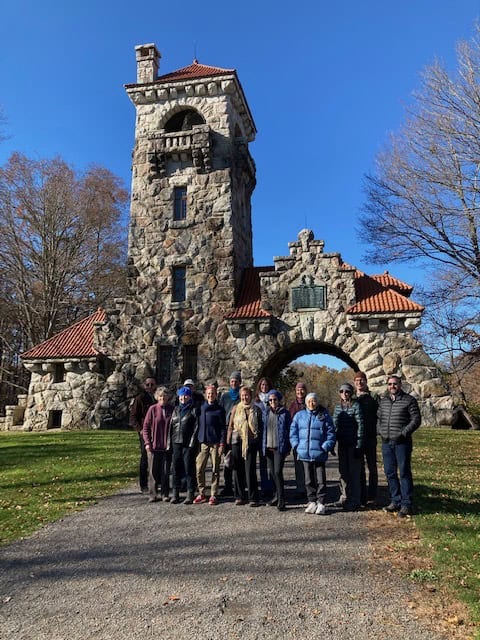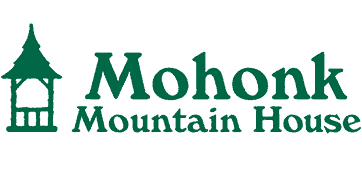By Louisa Finn, fourth generation Smiley family member
Episode #5: Testimonial Gateway
Quaker testimony is best understood as the public witness of an inward faith of both individual and community. It is the consequence of one’s relationship to God and the outworking of that relationship in one’s life. – Eric Moon, Friends Journal
The magnificent Testimonial Gateway set at the foothills of the Shawangunk Ridge was for 50 years the entryway to Mohonk, at first by horse and carriage (a 2 ½ hour trip to the hotel) and later by car. Bestowed upon Albert and Eliza Smiley for their 50th wedding anniversary in 1907 by their devoted Mohonk guests, the gateway cost $20,000–$500,000 in today’s dollars– collected in contributions of as little as $10 by more than 1,200 people. Since 1980, the gateway has also served as logo for Mohonk Consultations, a non-profit organization started by Keith Smiley, seeking solutions to local and global concerns through dialogue at Mohonk.
MOHONK CONFERENCES
Mohonk Consultations follows the tradition started by Albert K. and Eliza Smiley, and later carried on by Daniel and Effie, who hosted well-attended and illustrious conferences at Mohonk from the late 1800s until the advent of World War I. These included 21 conferences on International Arbitration which sought a global alternative to war, as well as 34 conferences on Native American policy which sought social reforms to governmental treatment of Indians.
Quakers do not separate religious and secular life, believing that all life should be lived ‘’in the spirit.” Friends have always believed that what was most important was how faith was lived out collectively in the world. The Quaker testimonials (beliefs) regarding peaceful means to settle disputes and the equality of all people under God required of the Smileys that they take personal responsibility for demonstrating these beliefs through action.
INTERNATIONAL CONNECTIONS
In addition to being a “guesthouse,” the Smileys envisioned Mohonk to serve as a politically neutral place from which people of influence might discuss the best way forward for humanity. Though limited as all humans are by the constraints of race, gender, class, religion, and historical era, the Smileys invited the greater world to their doorstep with generosity, in the name of making a better society.
It was fascinating timing that on the commemoration day for the Gateway: July 8, 1907, the second Conference on International Arbitration at the Hague in the Netherlands was taking place. This was referenced in the day’s proceedings, as the previously-held Mohonk Conferences birthed ideas and outcomes which had direct influence all the way across the ocean at the Hague. Seen in this way, the Testimonial Gateway served as the literal symbol of the relationship between Mohonk and the world, between inner belief and public practice.
CHANGES IN THE COUNTRY
As a marker of Albert K. and Eliza’s 50-year marriage, the gateway also served a marker of time and change in America. Judge George Perkins, speaking on behalf of the fund-raising committee, noted the changes in the country over the period from 1857 to 1907. Chief among these was the advent of railroads, uniting the Atlantic to the Pacific and effectively disappearing the frontier. Those 50 years of radical change in this country also included the acquisition of California and the addition of Texas to the Union, through the much controversied Mexican War. Not to mention that “the bloodiest civil war of all history was fought and the union of our states and our people made everlasting.” Technological advances included trolley cars, telephones, motor cars and wireless telegraphy throughout this 50 year period.
Well over 100 years later, it is sobering to consider the present time—the country as divided by opinion as it was before the Civil War, social unrest paramount and environmental devastation at a global tipping point. The last 50 years have also meant faster technological advances than at any period in human history. It is a time when many of us wonder and despair about the capacity of humanity to unite and do good for the benefit of all.
RESTORING THE GATEWAY
With this in mind, it is particularly fulfilling to see that the Gateway not only still stands, but is in the process of being lovingly restored by the Mohonk Preserve, whose land it occupies today. Made from Shawangunk Grit, it was clearly built to last, and continues to symbolize symbiotic relationships– between Mohonk and the Preserve, between village and mountaintop. The view from both the valley bottom (standing in the Gateway looking up the beautiful Oak Allee) to the ridge, as well as from the top (looking down from the SkyTop Road) is one of generous continuity of town, field and mountain, and beckoning to connect with nature. In the tradition of the Smileys, the gateway continues to encourage people to consider their relationship to the land and to the greater world. Though the days of worldwide influence at Mohonk have shifted to more regional efforts, the invitation continues through Mohonk Consultations to “come talk it over at Mohonk,” hosting conferences and forums on subjects such as solving the waste crisis and promoting food justice.
I trust that many generations of men will pass through that portal and climb the mountain through fine scenery, over well-built roadways and find on the height not only a well ordered hostelry, but more—a home where warmest greetings will be extended and friendships cultivated; still more that eminent men shall meet here to discuss great national and international questions that pertain to the betterment of the world; and above all that the Omnipotent Creator and Ruler of the Universe, whose tender compassion notices a sparrow’s fall, may be fitly honored and reverenced by both hosts and guests till the solid stone gateway shall crumble into dust.
-Albert K. Smiley, July 8, 1907
 Louisa Finn is a fourth generation Smiley family member. She is Secretary for Mohonk Consultations, Speech/Language Therapist, and poet. Her mother, Patricia Smiley Guralnik, directed the Festival of the Arts at Mohonk following the death of her husband, pianist Robert Guralnik. As a child, Louisa spent many days visiting her grandmother, Rachel Orcutt Smiley, who, in her later years, lived in Mohonk’s tower room 271. Currently, Louisa enjoys spending time in the Mohonk Archives, and reading the letters of her ancestors. Their words help to confirm her strong sense of the value of place, and inspire her to share the way past voices can instruct the present, and the future.
Louisa Finn is a fourth generation Smiley family member. She is Secretary for Mohonk Consultations, Speech/Language Therapist, and poet. Her mother, Patricia Smiley Guralnik, directed the Festival of the Arts at Mohonk following the death of her husband, pianist Robert Guralnik. As a child, Louisa spent many days visiting her grandmother, Rachel Orcutt Smiley, who, in her later years, lived in Mohonk’s tower room 271. Currently, Louisa enjoys spending time in the Mohonk Archives, and reading the letters of her ancestors. Their words help to confirm her strong sense of the value of place, and inspire her to share the way past voices can instruct the present, and the future.

